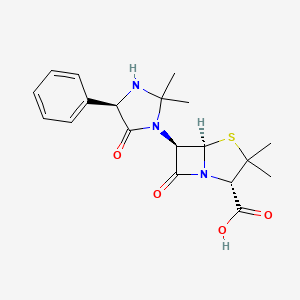



1. Hetacillin, (2s-(2alpha,5alpha,6alpha))-isomer
2. Hetacillin, Aluminum Salt (3:1), (2s-(2alpha,5alpha,6beta(s*)))-isomer
3. Hetacillin, Monopotassium Salt, (2s-(2alpha,5alpha,6beta(s*)))-isomer
4. Hetacillin, Monosodium Salt, (2s-(2alpha,5alpha,6beta(s*)))-isomer
5. Hetacillin, Monosodium Salt, (2s-(2alpha,5alpha,6beta))-isomer
6. Phenazacillin
1. 3511-16-8
2. Hetacillinum
3. Phenazacillin
4. Hetacilina
5. Hetacilline
6. Versapen
7. Bl-p 804
8. Hetacillin Acid
9. Brl-804
10. Tn4jsc48cv
11. Chebi:5683
12. (2s,5r,6r)-6-[(4r)-2,2-dimethyl-5-oxo-4-phenylimidazolidin-1-yl]-3,3-dimethyl-7-oxo-4-thia-1-azabicyclo[3.2.0]heptane-2-carboxylic Acid
13. Blp-804
14. Bl-p-804
15. 6-(2,2-dimethyl-5-oxo-4-phenyl-1-imidazolidinyl)-3,3-dimethyl-7-oxo-4-thia-1-azabicyclo(3.2.0)heptane-2-carboxylic Acid
16. 7-(2,2-dimethyl-5-oxo-4-phenyl-imidazolidin-1-yl)-3,3-dimethyl-6-oxo-2-thia-5-azabicyclo[3.2.0]heptane-4-carboxylic Acid
17. Etacillina
18. 6beta-[(4r)-2,2-dimethyl-5-oxo-4-phenylimidazolidin-1-yl]penicillanic Acid
19. Etacillina [dcit]
20. Brl 804
21. Unii-tn4jsc48cv
22. Hetacilina [inn-spanish]
23. Hetacilline [inn-french]
24. Hetacillinum [inn-latin]
25. Hetacillin [usan:usp:inn:ban]
26. Versapen (tn)
27. Einecs 222-512-5
28. Hetacillin [mi]
29. Hetacillin [inn]
30. Hetacillin (usan/inn)
31. Hetacillin [usan]
32. N,n'-isopropylidene-a-amino-benzyl Penicillin
33. Hetacillin [mart.]
34. Hetacillin [who-dd]
35. Schembl34131
36. Chembl1201116
37. Dtxsid4023121
38. Hetacillin [orange Book]
39. Zinc4102186
40. 6-(2,2-dimethyl-5-oxo-4-phenyl-1-imidazolidinyl)penicillansaeure
41. Hy-16251a
42. Cs-4870
43. Db00739
44. (2s,%r,6r)-6-(2,2-dimethyl-5-oxo-4-phenyl-1-imidazolidinyl)-3,3-dimethyl-7-oxo-4-thia-1-azabicyclo(3.2.0)heptan-2-carbonsaeure
45. D01074
46. Q5746710
47. (2s,5r,6r)-6-((r)-2,2-dimethyl-5-oxo-4-phenylimidazolidin-1-yl)-3,3-dimethyl-7-oxo-4-thia-1-azabicyclo[3.2.0]heptane-2-carboxylic Acid
48. 4-thia-1-azabicyclo(3.2.0)heptane-2-carboxylic Acid, 6-((4r)-2,2-dimethyl-5-oxo-4-phenyl-1-imidazolidinyl)-3,3-dimethyl-7-oxo-, (2s,5r,6r)-
49. 4-thia-1-azabicyclo(3.2.0)heptane-2-carboxylic Acid, 6-(2,2-dimethyl-5-oxo-4-phenyl-1-imidazolidinyl)-3,3-dimethyl-7-oxo-, (2s-(2.alpha.,5.alpha.,6.beta.(s*)))-
50. 4-thia-1-azabicyclo(3.2.0)heptane-2-carboxylic Acid, 6-(2,2-dimethyl-5-oxo-4-phenyl-1-imidazolidinyl)-3,3-dimethyl-7-oxo-, (2s-(2alpha,5alpha,6beta(s*)))-
51. 6beta-[(4r)-2,2-dimethyl-5-oxo-4-phenylimidazolidin-1-yl]-2,2-dimethylpenam-3alpha-carboxylic Acid
| Molecular Weight | 389.5 g/mol |
|---|---|
| Molecular Formula | C19H23N3O4S |
| XLogP3 | -0.6 |
| Hydrogen Bond Donor Count | 2 |
| Hydrogen Bond Acceptor Count | 6 |
| Rotatable Bond Count | 3 |
| Exact Mass | 389.14092740 g/mol |
| Monoisotopic Mass | 389.14092740 g/mol |
| Topological Polar Surface Area | 115 Ų |
| Heavy Atom Count | 27 |
| Formal Charge | 0 |
| Complexity | 688 |
| Isotope Atom Count | 0 |
| Defined Atom Stereocenter Count | 4 |
| Undefined Atom Stereocenter Count | 0 |
| Defined Bond Stereocenter Count | 0 |
| Undefined Bond Stereocenter Count | 0 |
| Covalently Bonded Unit Count | 1 |
Hetacillin is a beta-lactam antibiotic prodrug used to treat bacterial infections. In the body it gets converted to ampicillin.
Hetacillin is a penicillin beta-lactam antibiotic used in the treatment of bacterial infections caused by susceptible, usually gram-positive, organisms. The name "penicillin" can either refer to several variants of penicillin available, or to the group of antibiotics derived from the penicillins. Hetacillin has in vitro activity against gram-positive and gram-negative aerobic and anaerobic bacteria. The bactericidal activity of Hetacillin results from the inhibition of cell wall synthesis and is mediated through Hetacillin binding to penicillin binding proteins (PBPs).
J - Antiinfectives for systemic use
J01 - Antibacterials for systemic use
J01C - Beta-lactam antibacterials, penicillins
J01CA - Penicillins with extended spectrum
J01CA18 - Hetacillin
Hydrolyzed to active ampicillin via esterases
Hetacillin is a semisynthetic penicillin prodrug which itself has no antibacterial activity, but is converted in the body to ampicillin and has actions and uses similar to those of ampicillin. Hetacillin is prepared by reacting ampicillin with acetone. Ampicillin rapidly decomposes because of the intramolecular attack of the side chain amino group on the lactam ring. _In vitro_ studies have shown that hetacillin is resistant to beta lactamase activity. However, this effect is transient, as the hydrolysis product, ampicillin, is readily inactivated by beta lactamase. Hetacillin locks up the offending amino group and prevents the decomposition of Hetacillin. Once hydrolyzed to ampicillin (and acetone), ampicillin binds to the penicillin binding proteins found in susceptible bacteria. This inhibits the third and last stage of bacterial cell wall synthesis. Cell lysis is then mediated by bacterial cell wall autolytic enzymes such as autolysins.